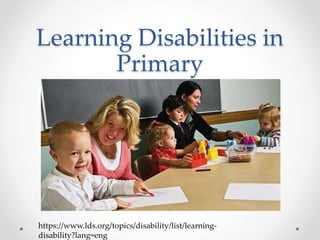Learning disabilities in primary for presenter
- 3. The Learning Process A person with a learning disability has difficulty taking in, remembering, or expressing information. INFORMATION Taking in information MEMORY Understanding, Processing and Filing it to Memory EXPRESSION Withdrawing information and using it in the outside worldFrom ŌĆ£Walk a Mile in My ShoesŌĆØ Learning Disabilities Association of Ottawa - Carleton
- 4. BC Ministry Definition ŌĆó http://www.bced.gov.bc.ca/specialed/docs/learni ng_disabilities_guide.pdf
- 5. ŌĆó Learning Disabilities refer to a number of conditions that might affect the acquisition, organization, retention, understanding or use of verbal or nonverbal information. These disorders affect learning in individuals who otherwise demonstrate at least average abilities essential for thinking and/or reasoning. As such, learning disabilities are distinct from global intellectual disabilities.
- 6. ŌĆó Learning disabilities result from impairments in one or more processes related to perceiving, thinking, remembering or learning. These include, but are not limited to language processing, phonological processing, visual spatial processing, processing speed, memory, attention and executive functions (e.g. planning and decision making). ŌĆó .
- 7. ŌĆó Learning disabilities vary in severity and may interfere with the acquisition and use of one or more of the following: ŌĆó oral language (e.g., listening, speaking, understanding) ŌĆó reading (e.g., decoding, phonetic knowledge, word recognition, comprehension) ŌĆó written language (e.g., spelling and written expression) ŌĆó mathematics (e.g., computation, problem solving)
- 8. ŌĆó Learning disabilities may also involve difficulties with organizational skills, social perception, social interaction and perspective taking.
- 9. ŌĆó Learning disabilities are life-long. The way in which they are expressed may vary over an individualŌĆÖs lifetime, depending on the interaction between the demands of the environment and the individualŌĆÖs strengths and needs. Learning disabilities are suggested by unexpected academic under-achievement or achievement that is maintained only by unusually high levels of effort and support.
- 10. Understanding Learning Disabilities From LDS.org ŌĆó Individuals who have learning disabilities may exhibit a variety of difficulties, including problems with reading, spoken language, writing, or reasoning ability. Hyperactivity and inattention may also be associated with learning disabilities. Coordination, behavior, and interactions with others may also be affected. ŌĆó An individual with learning disabilities may have average or above average intelligence. However, he or she may have difficulties in a classroom setting without appropriate support and accommodation.
- 12. Your Job ŌĆó Help them feel accepted and loved. ŌĆó Help them build a testimony. ŌĆó Adapt, adapt, adapt. ŌĆó You do not have to teach them to read, leave it to home and school.
- 13. Ways to Help ŌĆó Focus on correct answers and behaviors. Acknowledge and commend the personŌĆÖs efforts. ŌĆó Encourage each person to be involved, and focus on his or her abilities. ŌĆó Build confidence by providing support and appropriate opportunities to serve.
- 14. Teaching Tips ŌĆó Prayerfully present well-prepared lessons in a variety of formats, including print, audio, and visual resources.
- 15. Teaching Tips ŌĆó Provide an environment where class members are comfortable asking questions about things they donŌĆÖt understand.
- 16. Teaching Tips ŌĆó Outline the class schedule and order of events for the class time.
- 17. Resources ŌĆó Church Media Library ŌĆó https://www.lds.org/media- library/images?lang=eng
- 18. Teaching Tips ŌĆó Allow the student time to process the information, donŌĆÖt put them on the spot.
- 19. Teaching Tips ŌĆó A ŌĆ£read-alongŌĆØ technique using recorded materials may help individuals who have difficulty reading.
- 20. Teaching Tips ŌĆó Introduce and explain vocabulary before teaching a lesson. Review new words and information frequently.
- 21. Teaching Tips ŌĆó If writing is a challenge, donŌĆÖt make them write. Either skip it or have a student or yourself scribe for them.
- 22. Teaching Tips ŌĆó Include movement. A child can stay focused for approx. 1 minute per year of their age (ie. 8 min. for 8 year olds). Often this is less. Movement is very important. ŌĆó Make it part of the lesson if possible.
- 23. Teaching Tips ŌĆó Prayerfully strive to understand the personŌĆÖs learning style and how the person best expresses what he or she knows. Play to the personŌĆÖs strengths. ŌĆó (GardnerŌĆÖs Multiple Intelligences)
- 24. Teaching Tips ŌĆó Treat the person as intelligent. He or she is intelligent. ŌĆó Make accommodations as natural as possible so as to not single an individual out in front of his or her peers.
- 25. Teaching Tips ŌĆó Rather than just rehearsing facts, teach by sharing experiences and feelings about the gospel. Learning is easier when people become spiritually and emotionally involved.
- 26. Teaching Tips ŌĆó Minimize distractions
- 27. Helpful Resources ŌĆó Learning Disabilities Association of British Columbia http://www.ldabc.ca ŌĆó LD Online http://www.ldonline.org ŌĆó National Center for Learning Disabilities.org http://ncld.org ŌĆó LDS.org http://www.lds.org o Media library => serve & teach => primary => primary symbols for teaching
- 28. Questions?
Editor's Notes
- #17: Demonstrate on the board what a visual schedule might look like



























